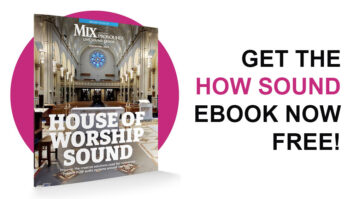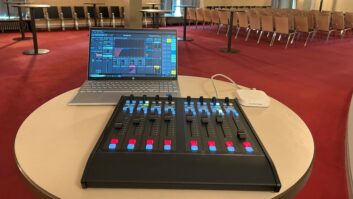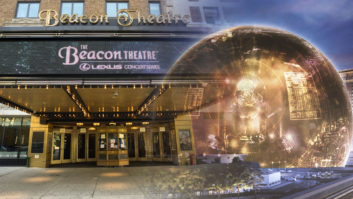The expansive Studio A live room at Kaleidoscope Sound in Union City, NJ, sports two iso booths, a drum room (not seen) and a big collection of new and vintage gear. Union City, NJ-based Kaleidescope Sound is a two-room facility that has been helping musicians make records since 2002. Founded on the principle “all music, no attitude,” Kaleidescope recently expanded its footprint with its latest addition, The Patio, which features a control room, a comfortable live room and two large isolation rooms.

For Randy Crafton, who owns Kaleidescope and is also one of the company’s engineer/producers, the expansion happened organically as demand for his services increased— particularly in areas such as film and 5.1 mixing projects. Crafton was careful to keep his existing customer base in mind, which helped him achieve this success in the first place. “I work with musicians and a few small labels; mostly with guys that get a small budget together, come in and do a record. That’s my client,” he explains. “I found myself in that tricky spot of wanting to continue to work with some of New York’s finest and hardest working musicians that I’ve known for 25 years, while saying ‘yes’ to the larger-budget projects I was being offered. The only way I saw to do this was to build another room.”
Crafton turned to Fran Manzella of NY-based Francis Manzella Design Ltd., who had assisted him five years earlier during an upgrade of Studio A’s control room. “I liked Fran, because he was really straight up and honest,” says Crafton. “Also, I had worked in his rooms before, and I just knew that every room of his I had ever worked in sounded consistent and made sense to me.” That project—which was completed in just nine weeks—was a huge success, and Crafton, who had also installed an API Legacy Plus at the time, appreciated the acoustic response and overall accuracy of the new control room. “It was ergonomically correct and it all worked really well,” he says.
About two years ago, when it was time to begin work on The Patio, Crafton wasted no time in contacting Manzella once again. “I got my old team back to together that renovated the control room in Studio A—Fran; John Ambrossi at Sound Matters contracting; my in-house guy, Sal Mormando, who does all my wiring; and my fabric guy,” he says. Ever confident of his ongoing success, Crafton took a 15-year lease on the building next door to accommodate the space where The Patio was to be located.
For Manzella, the most difficult task during the project was bringing the building into a state that would support the new construction: “As we got into looking at the building more closely, there were a lot of upgrades we needed to make to the structure itself,” Manzella recalls. “Everything from the roof to the floor had to be rehabilitated before we could build a studio, but now it is a clean, multi-functional studio. It’s a departure from Studio A since it’s all digital, but that’s what he wanted in order to do more surround, post and television work.”
Kaleidoscope’s owner, Randy Crafton, recently opened a second facility next door, The Patio, to handle his rising workload in film and 5.1 mixing. One of the things Crafton likes best about the new room is its sonic consistency and predictability. “The control room is as ‘what you hear is what you get’ as any room I’ve ever worked in,” he observes. “When I am tracking, I feel that there is none of that kind of ‘internal filter compensation,’ where you constantly tell yourself things like, ‘I know the bass sounds a little loud here, but it’s going to be perfect everywhere else.’” According to Crafton, two of the most difficult things to monitor in a studio are vocal and bass levels, both of which he says are now nearly effortless. “In this room, I never wonder,” he says. “I don’t have to reference on a bunch of speakers. I just listen to it on the speakers we set up and if it sounds right here, I know it is going to sound right in a variety of circumstances.”

From an equipment perspective, an Avid Icon D-Control was chosen to complement the Pro Tools rig, which represents a digital contrast to the API analog console in Studio A. An API summing capability that imparts an analog flavor accompanies the Avid set up. “We chose the Avid [controller] because the room was set up to do surround mixing. You can’t work on a mouse and do 5.1 mixes!” says Crafton. “Also, it was the most practical decision, since we didn’t want to overwhelm the room with a big console and make it into something it didn’t want to be.”
For preamps, he gathered several mic pre modules he had from his old console before the API in Studio A—including 10 Putnam 1108s, 10 API 312s and others—and had them racked with power supplies and placed in the live room. “We took a page out of Walter Sear’s book and set them up in the live room to get the mic signal to the preamplifier as fast as possible, then send that amplified signal into the control room,” says Crafton. There is also a nice compliment of Neve, API, and other more traditional mic pres in the control room as well as a host of compressors and EQs.
Crafton is equally as pleased with The Patio’s new live room, which he says is very flexible and has already been used to record a diversity of instruments. “The first three sessions I did in the live room convinced me the room was right,” he says. “I recorded rock drums, a horn session and a string quartet. When I recorded the string quartet, I was finally able to do what I always imagined I should be able to do, which was to get 80 percent of the sound from a stereo pair of Neumann M 49 tube mics in the room.”
At the end of the day, his expansion plan worked. Crafton ended up getting more than he bargained for and has an increasingly steady stream of clients: “I ended up making The Patio addition a whole lot better than I ever thought to make it,” he says. While he admits he went overbudget, he still feels it was money well spent. “At a certain point, you have to ask yourself that if you’re not doing it well, then why are you doing it at all?”
Kaleidoscope Sound
kaleidoscopesound.com
Jacques Sonyieux is a devout explorer of recording studios and the artists that inhabit them. Please send any tips or feedback to Jacques at: jacquessonyieux@gmail.com.






